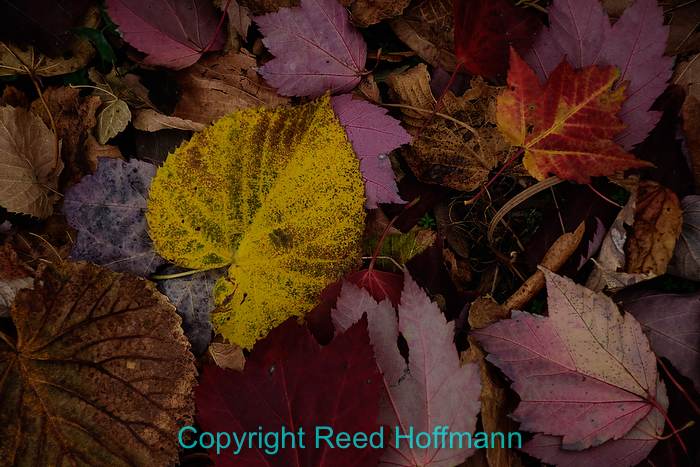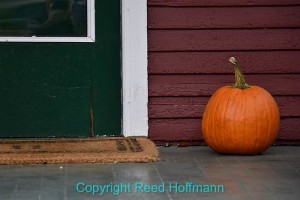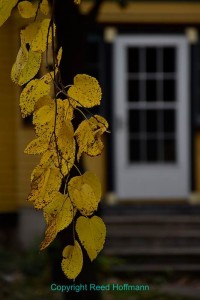One of the joys of living someplace with four seasons is watching them come and go. Fall has always been my favorite of the bunch, with its change of color. Of course that’s especially nice if you’re into photography. But it also presents two big problems – it doesn’t last long, and it’s actually hard to shoot.
Recently I went to South Bend to teach Mylio classes and a workshop. Driving over from Chicago, once into northern Indiana I was blown away by the amount of color. Yellow, orange, red and every hue in between, it was some of the richest fall foliage I’d seen in a long time. With the shortness of the season and having a couple of hours to spare, I decided to take a break from the drive, get off the highway and shoot despite the cloudy day. Which brought me to the second problem.
Most people think fall color is easy to shoot. After all, it’s pretty, so just shoot pictures, right? But that’s exactly why most people fail. Every picture needs a subject. And while a bunch of colorful leaves can be pretty, well, they’re still just a bunch of colorful leaves. Where’s the subject? So every year I try to shoot fall foliage, and every year I’m reminded how hard that can be.
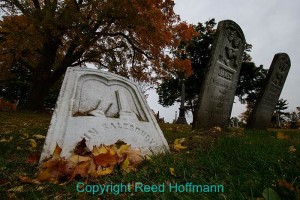
First good picture I found, in an old cemetery. Nikon D5500, Aperture Priority, ISO 200, 1/160 at f/10, EV +0.3, Nikon 10-24mm lens at 10mm. Photo copyright Reed Hoffmann.
Getting off the highway, the first thing I did was pull over and call up Google Maps. I knew I needed more than just leaves, and one way to do that is to find water. As it turns out, LaPorte, Indiana has a bunch of lakes around it, and was nearby. So that’s where I headed.
My first stop was at an old cemetery. Despite all the trees and color, I couldn’t find a shot that seemed to work. That problem of color, but no subject. So I decided to look elsewhere. On the way out, I saw something that might make a subject – some old tombstones. It made a nice composition, with a light one in front and two darker ones to the side in back. But there was another problem, because it was overcast. Those skies are hard to work with, because to the camera, they’re a big blank slate of white. I wanted to use a low angle to bring the trees in, but that would emphasize the sky. In this case though, I could put the camera down there and those darker stones would partially block the sky. Bingo.
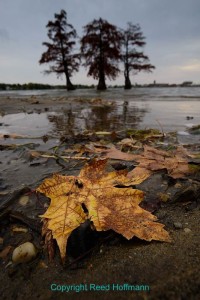
Same idea, up close to the foreground subject. D5500, Aperture Priority, ISO 400, 1/125 at f/11, EV -0.3, Nikon 10-24mm lens at 13mm. Photo copyright Reed Hoffmann.
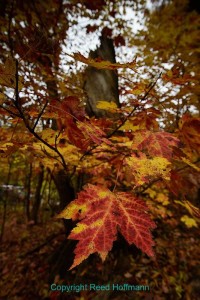
Strong foreground element, supporting background. Nikon D5500, Aperture Priority, ISO 200, 1/80 at f/6.3, EV -0.3, Nikon 10-24mm lens at 14mm. Photo copyright Reed Hoffmann.
Next stop was at some of those lakes on the map. I first looked for reflections, but no luck there. That meant it was time to take a walk. I wanted to find a nice leaf to put in the foreground, with lots of color behind it. Found one, with an old stump behind it that would again add a secondary element, and also help block that dreadful sky.
For both of those shots I used a super-wide lens (10-24mm with an APS-C sensor camera). I’m a big fan of that type of lens because it lets me get close, creating a prominent foreground subject, while also including a background that adds to the picture. I’d continue working with that lens, doing another shot along the edge of a lake. I’d found a great grouping of three trees, but again, couldn’t find a good shot of just them. As a background behind the leaf, though, they worked pretty well.
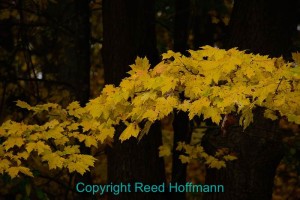
Shape and color. Nikon D5500, Aperture Priority, ISO 400, 1/160 at f/7.1, EV -1.0, Nikon 18-140mm lens at 140mm. Photo copyright Reed Hoffmann.
Another thing I’ll look for is patterns, shapes and lines in all that color. Behind a nearby skate park I found a good bunch of yellow leaves. What made that work was not just the curve of color, but the dark background. If you want people to look at your subject, dark backgrounds really help. With bright yellow leaves, I could even underexpose a little, which would help the color of those leaves go richer (deeper), while at the same time making the background even darker.
By then it was time to head to South Bend for my evening class. On the way there I stopped by a park we were planning to visit the next day during the shooting workshop. I quickly decided I didn’t love the park, but up a nearby hill were some homes that looked interesting. Walking over, I found
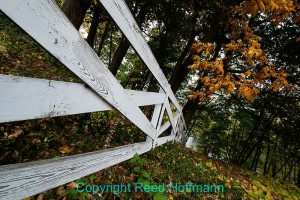
Using the lines of the fence to draw the eye to the color of the leaves. Nikon D5500, Aperture Priority, ISO 400, 1/60 at f/8, Nikon 10-24mm lens at 10mm. Photo copyright Reed Hoffmann.
the nearest had a nice old white fence along the edge of the yard. It was easy to use its leading lines to guide the eye to another bunch of colorful leaves below. While I’m not normally a fan of tilted shots, in this case I think (I hope!) it works.
That led me to a beautiful little neighborhood of old homes. Fertile ground for photos, and a nice change from the nature shots I’d been doing. It would also be perfect for the workshop, as we could work with a different kind of line and shape. Finally, it would also be a nice counter to the flowers and plants at the other shoot scheduled at a local conservatory.
The classes went well, and the workshop was a lot of fun. That old neighborhood was so rich in photos we spent more time there than planned. And the conservatory was nice too. I never saw the sun during those two days, but that didn’t end up mattering. We had great fall color to work with, and even better, some great subjects. And that’s what makes good pictures – not just color, but subjects.

